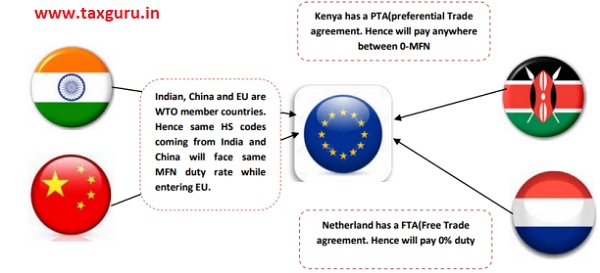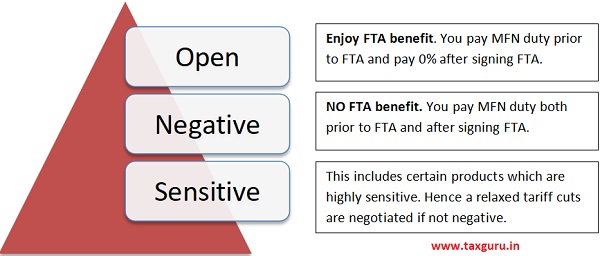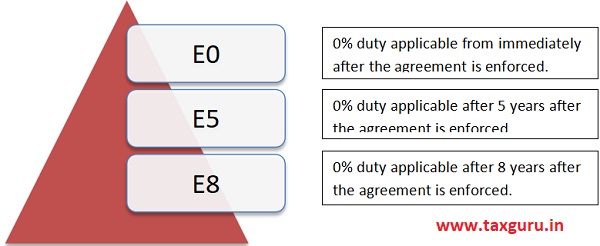
CA Prachi Jain
Indian government has entered as well as in process of entering into trade agreements across both developed and developing markets including FTA with ASEAN/Srilanka, PTA with Peru, Afghanistan, MERCOSUR, CEPA with Korea and Japan, CECA with Singapore and Malaysia and similar possibilities with Canada, Australia, EU, China etc. In light of various initiatives taken by India towards signing of regional and bilateral trading agreements, it does make sense for exporting units to consider diversifying from the traditional markets of USA, EU and Japan etc to new emerging economies including LAC, Africa, ASEAN, Korea and other Asian markets etc. A basic understanding of these RTAs to an exporter mean a direct trade benefit to the signing country as against the competitive players from other supplying countries which do not have such agreements signed in the same market. At the same time, domestic companies operating in India would always feel threatened to lose price competitiveness against the cheap imports to be encouraged into the country as a result of Indian Government reducing tariffs with RTA signing partners globally.
What is Trade Agreement?
Trade agreement is nothing but a legal binding between two or more countries wherein the trading countries commits certain benefits only to their signing partners which is not to be availed by countries outside the agreement. This benefit can be extended to goods (in terms of offering a lower or zero import duty to the imports coming from countries within agreement), services or facilitation of investment and many more benefits.
Page Contents
- How do these trade agreements benefit an exporter?
- Does this logic hold true for Indian importers too?
- Does RTAs always assure you of an export opportunity?
- Does this mean that if your product is in open list, you will always enjoy a relaxed duty rate?
- Does it mean if my product is in E5 category I will not benefit through this FTA for next 5 years?
How do these trade agreements benefit an exporter?
To understand the benefit of an Regional Trade Agreements, we need to first understand the concept of WTO MFN status. The World Trade Organisation which was signed between many countries in Jan 1995 brings forth a concept of “Most Favoured Nation” which means that if the exporting country and the importing country both are WTO members then the importing country will give equal treatment to all the exporting country in terms of both tariff and non-tariff barriers. Let’s dig deeper and understand this from an Indian exporter’s perspective. Suppose Mr. X is the supplier of flowers from India HS code 060310. He finds a buyer in the EU. He finds EU offers an import duty of 27% for this HS code. He also figures out that his competing players supplying same HS code to the EU are Kenya, China and Netherlands.

Hence this means Indian exporters would gain similar benefits against their competing countries if they choose to trade with countries where India has signed trade agreement which enables them to enter the trading partner at something less than MFN if it is a PTA (MERCOSUR, Afghanistan, SAPTA, Chile etc) or at zero duty rates if India has signed an FTA (ASEAN/ Srilanka etc).
Does this logic hold true for Indian importers too?
Yes!! This logic holds true for an importer who would have to pay MFN duty rate if he procures from countries with which India does not have trade agreement since in the absence of any trade agreement, Indian government is bound to charge MFN duty rate from all the supplying countries. An importer can avoid paying import duty and thus save his cost if he shifts his sourcing from non RTA countries to the ones with which India has a trade agreement which gives Indian Government liberty to reduce import duty for imports coming from FTA/PTA partner countries.
Does RTAs always assure you of an export opportunity?
No it’s not always the case. Let’s analyse three scenarios to understand why signing a trade agreement does not always guarantee export benefit. When you plan to trade with any country against your competing player supplying same product to that market there can be three scenarios:
| Option | RTA status with supplying country | Example | Query | Response | |
| India | Competitor | ||||
| Option 1 | √ | x | India has RTA with Thailand but Canada does not | Will Indian Exporter have better chances than Canadians in Thai market only coz of RTA? | NO!! |
| Option 2 | x | √ | India does not have RTA with the USA but Canada has. | Can Indian exporter never operate against Mexican players in the USA? | NO!! |
| Option 3 | √ | √ | Both India and China has RTA with ASEAN Countries | Will India and China have equal advantage in ASEAN? | NO!! |
Now let’s understand why we answer No!! in all the above cases. Which also means that just having an RTA between India and the target export market does not assure an Indian exporter of having a good export opportunity for his product; since it depends on the status of his product in that RTA. Let’s understand these status. Whenever, two countries sign a trade agreement amongst themselves, the two Governments are technically discussing over 10,000 tariff lines at 6 digit HS codes. Amongst these tariff lines there are many commodities in which both trading partners may possess production strength and thus both countries would want to export and not import and therefore would not like to reduce the import duties on such products even after signing a trade agreement. Say for instance in case of Indo-ASEAN FTA, both India and almost all the ASEAN countries including Myanmar, Thailand, Philippines, Lao, Cambodia, Vietnam etc. are good at producing rice. So in such a scenario India as well as ASEAN economies will certainly have the threat of import surge from each other on account of fall in duty rates as a result of signing trade agreement. Hence whenever the agreements are signed these 10,000 tariff lines are divided into three categories:

Does this mean that if your product is in open list, you will always enjoy a relaxed duty rate?
No!! Your product if indicated in the open list, it indicates that it will enjoy FTA duty rate of zero percent. But the importing country may decide on the time when it would like to offer that FTA duty rate. This gives additional consideration of exact timelines when the benefits would start depending on the status to the products listed under open category.This will get clear form the example of Agreement with South Korea:-

Does it mean if my product is in E5 category I will not benefit through this FTA for next 5 years?
No!! This only means that you will not be benefitted to the extent the product lines in E0 are, but you still get some benefit against your competing players not having the FTA. Because the product in E5 means that you will enjoy 0% duty after 5 years but each year there will be gradual decline. Let’s take an example, in Indo-South Korea CEPA, suppose the MFN rate of duty for your product is 100%. Hence you and your competing player both were entering Korea paying 100% import duty. Now India signs an agreement with Korea in Jan 2010 with your product status as E5 and competing player does not have the RTA. This means that your product will enjoy 0% duty rate only by 2010+5=2015. However each year the reduction will take place on equal installment of 100/5=20% giving you an additional edge of 20% each year against your competing supplier of same product to South Korea.
Now that we have understood the concepts of open, negative and sensitive list let’s take a look at the above table once again.
| Option | RTA status with supplying country | Query | Response | |
| India | Competitor | |||
| Option 1 | √ | x | Will Indian Exporter have better chances than Canadians in Thai market only coz of RTA? | No!!
Indian exporter will only have better chance if he picks up the right 6 digit HS code which falls into the open list.Else he is at par with the competing player paying MFN rate of duty despite India having an RTA. |
| Option 2 | x | √ | Can Indian exporter never operate against Mexican players in the USA? | NO!!
Indian exporter shouldn’t feel threatened.Since if he picks up the product which falls in the negative list of competing country and importing country’s RTA, the RTA benefit to latter will be declined. |
| Option 3 | √
(open) |
√
(open) |
Will India and China have equal advantage in ASEAN? | NO!!
Indian exporter should concentrate on E0 products as against E5/E8 for his competing player. |
What do you need to do in order to avail the benefit?
Even if your product is in open list in the trading agreement; it still does not assure you of free entry into trading partner country until the time you prove the customs of the importing country that the product on which you are requesting the tariff concession actually is an Indian made product. Appreciating the fact that the trade agreement is signed between two countries, importing country would certainly like to offer this benefit to ONLY those products which would originate within the countries signing trade agreement. This concern is termed as “Rules of Origin”.
From where these Trade Agreements can be find?
One can find the trade agreements signed by India with other countries at www.commerce.gov.in as well as on www.wto.org.
Sources:-
www.dgft.gov.in
www.commerce.gov.in
www.wto.org
(Author Prachi Jain is Partner with GAPP & Company, Chartered Accountants and can be reached Caprachij0810@gmail.com)




